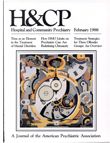An Overview of Psychiatric Treatment Approaches to Three Offender Groups
Abstract
The chances for successful management of three groups of mentally ill offenders—insanity acquittees, sexual offenders, and offenders with alcohol problems—can be maximized by using specific diagnostic and therapeutic techniques for each group. The recommended model for treatment of insanity acquittees is based on a single administrative organization to oversee treatment programs, which include dearly defined inpatient and outpatient components and careful monitoring of conditional release to the community. Techniques for the diagnosis of sexual offenders include bioimpedance and physiological measures of sex hormone levels and penile tumescence. Medication with antiandrogens and cognitive behavioral treatment using covert sensitization and operant aversion are among the appropriate therapeutic modalities. Treatment of persons charged with alcoholrelated crimes should be matched to the severity of the alcohol problem. Legal intervention supplemented by brief treatment programs may be effective for offenders with lesser degrees of alcohol abuse. For offenders with more serious alcohol problems, longer group treatment or detoxification may be necessary. Treatment of alcoholic criminals may be most effective in peer groups in institutional settings, where legal coercion can be used to encourage compliance.
Access content
To read the fulltext, please use one of the options below to sign in or purchase access.- Personal login
- Institutional Login
- Sign in via OpenAthens
- Register for access
-
Please login/register if you wish to pair your device and check access availability.
Not a subscriber?
PsychiatryOnline subscription options offer access to the DSM-5 library, books, journals, CME, and patient resources. This all-in-one virtual library provides psychiatrists and mental health professionals with key resources for diagnosis, treatment, research, and professional development.
Need more help? PsychiatryOnline Customer Service may be reached by emailing [email protected] or by calling 800-368-5777 (in the U.S.) or 703-907-7322 (outside the U.S.).



